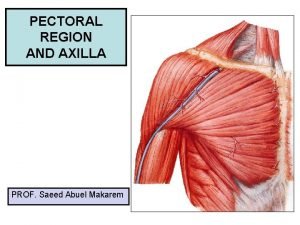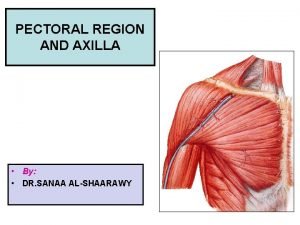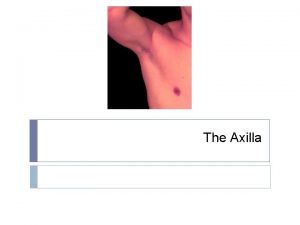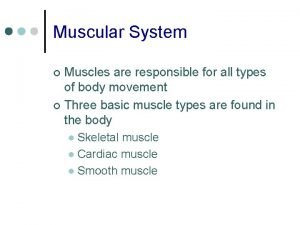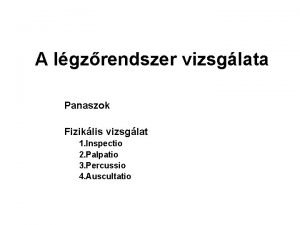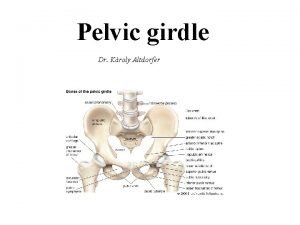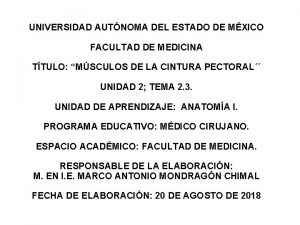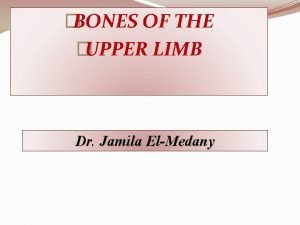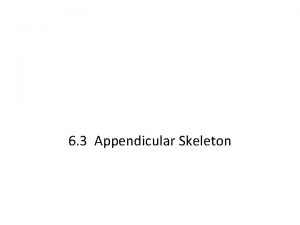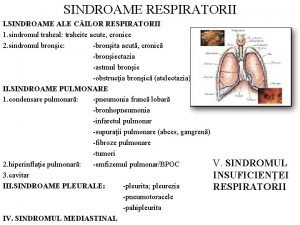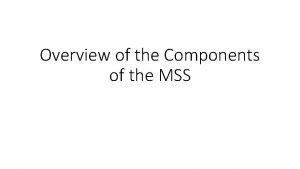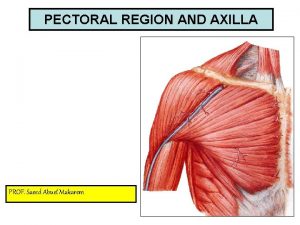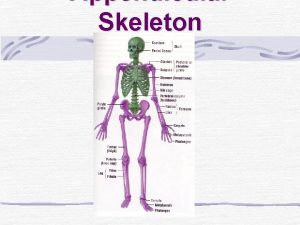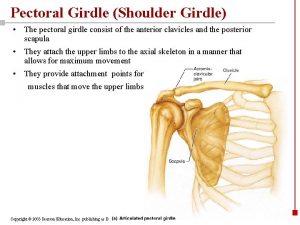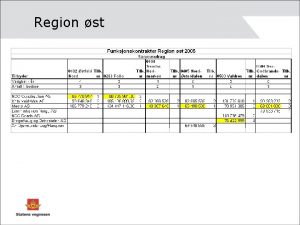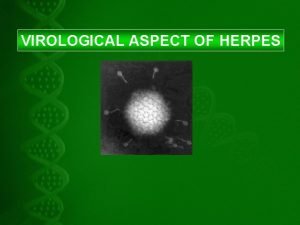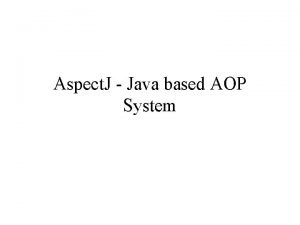The Pectoral Region Pectoral region is the Aspect





























- Slides: 29

The Pectoral Region Pectoral region is the Aspect of the Chest bounded by or Containing: A. The Pectoralis Major Muscle, B. Including the Lateral Pectoral, C. Mammary, and D. Inframammary Regions. 12/11/2021 1

The Pectoral Region The Breasts are milk-producing (mammary) glands surrounded by fat and the female breast consists mainly of fat and breast tissue, along with the various nerves, veins, arteries and connective tissue that hold everything together. ligaments. 12/11/2021 2

The Pectoral Region Attached to the front of the chest by ligaments. They rest on the pectoralis major muscle, but has no muscle tissue itself. The Fat in the Breasts determines their shape and size, which varies among women. 12/11/2021 3

The Pectoral Region though the Size of the Mammary Gland System is Relatively Standard. In addition, women Commonly Have one Breast Larger than the Other. The Mammary Gland conical in shape, having: An Apex is the Nipple, surrounded by th Areola is around the nipple. 12/11/2021 4

The Pectoral Region A Base: nd th 2 – 6 Ribs, Sternal border to Mid Axillary line It lies in the superficial fascia mainly, Except Axillary Tail. Deep to the gland is the Retro Mammary Space. 12/11/2021 5

The Pectoral Region The gland has 15 – 20 Lobes, separated by septa (Suspensory Ligaments) extending from skin to deep fascia. Lymphatics run with these Ligaments. ? ? 12/11/2021 6

The Pectoral Region Each lobe has a Lactiferous Duct. The ducts converge on the nipple, each has a Dilated Ampulla, the Lactiferous Sinus. Arterial Blood Supply: 12/11/2021 7

The Pectoral Region 1. Lateral Thoracic 2. Thoracoacromial 3. Perforating Branches of Internal Thoracic 4. Intercostal Arteries Venous Drainage: Veins that correspond to the Arteries. 12/11/2021 8

The Pectoral Region 12/11/2021 9

The Pectoral Region Breasts begin developing between the ages of 9 and 14. Its growth signals the start of puberty. Breast tissue is highly sensitive to the hormones: Estrogen, Progesterone, and Prolactin throughout the menstrual cycle. During Breastfeeding, Prolactin triggers Milk Production within the breast. 12/11/2021 10

The Pectoral Region Lobules, Alveoli, & Ducts: Breasts have 15 to 20 sections, Lobes or Lobules that converge at the nipple. Each lobule consists of Sacs called Alveoli, and the lobules are connected through ducts. Final collection area for milk is known as the Main Duct. 12/11/2021 11

The Pectoral Region During breastfeeding, Prolactin stimulates the alveoli to Absorbs nutrients from the woman’s blood to produce breast milk. Oxytocin causes the alveoli to release the milk through the Mammary Ducts to the nipple. 12/11/2021 12

The Pectoral Region 12/11/2021 13

The Pectoral Region 12/11/2021 14

The Pectoral Region 12/11/2021 15

The Pectoral Region 12/11/2021 16

The Pectoral Region Nipple: Also known as the Mammary Papilla, the nipple is the outlet for the mammary ducts where milk is secreted. Areola: is the round pigmented area surrounding the nipple. During breastfeeding, small bumps on the areola known as Montgomery Glands produce an oily substance that cleans a& lubricates the nipple. 12/11/2021 17

The Pectoral Region Lymph Nodes: The lymphatic system helps fight infection & malignancy by capturing & excreting pathogens & toxins through lymph nodes & ducts. These nodes are found: Near the breast, In the Axilla, Behind the Sternum & in Intercostal Spaces, In the Supraclavicular Region, In the abdomen, at Liver Hilum. 12/11/2021 18

The Pectoral Region Often, axillary lymph nodes are removed during mastectomy. Suspensory Ligaments (Cooper’s Ligaments) This ligament is often called “God’s Bra” “Nature’s Bra” because it lifts the breast and prevents it from sagging. 12/11/2021 19

The Pectoral Region Normal adult women will have about 15 to 20 Lobes in each breast and each lobe will have 20 to 40 Lobules. The breast tissue is mature but inactive until pregnancy, when the lobules will begin to grow larger and ultimately produce milk allowing a mother to breastfeed her baby. 12/11/2021 20

The Pectoral Region After menopause, the number of lobules in the breast tissue decreases and those that do remain will begin to shrink in size. This means that post-menopausal breasts are composed of less actual breast issue and contain more fat. 12/11/2021 21

The Pectoral Region Lymph Node Areas Adjacent to Breast Area : A. Pectoralis major muscle B. Axillary lymph nodes: levels I C. Axillary lymph nodes: levels II D. Axillary lymph nodes: levels III E. Supraclavicular lymph nodes F. Internal mammary lymph nodes 12/11/2021 22

The Pectoral Region G. Liver hilum nodes H. Anterior intercostal lymph nodes 12/11/2021 23

The Pectoral Region 12/11/2021 24

The Pectoral Region 12/11/2021 25

The Pectoral Region 12/11/2021 26

The Pectoral Region 12/11/2021 27

The Pectoral Region 12/11/2021 28

The Pectoral Region 12/11/2021 29
 Les aspects d'un texte
Les aspects d'un texte Superficial fascia of pectoral region
Superficial fascia of pectoral region Pectoralis major
Pectoralis major Axilla anatomy
Axilla anatomy Serratus anterior nerve
Serratus anterior nerve Lateral thoracic vessels
Lateral thoracic vessels Pectoral girdle
Pectoral girdle Inferior oblique
Inferior oblique Hypersonor
Hypersonor Suprahumeral joint
Suprahumeral joint Exercise 15 spinal cord and spinal nerves
Exercise 15 spinal cord and spinal nerves Astheniás
Astheniás Pelvic gurdle
Pelvic gurdle Transversospinales
Transversospinales Types of body positions in nursing
Types of body positions in nursing Supraespinoso origen inserción inervación y acción
Supraespinoso origen inserción inervación y acción Supinador largo
Supinador largo Pectoral machine
Pectoral machine Biding pektoral girdle and humerus
Biding pektoral girdle and humerus Pectoral girdle
Pectoral girdle Pahipleurita rx
Pahipleurita rx Comblement sillon delto pectoral
Comblement sillon delto pectoral Pectoral fascia
Pectoral fascia Pectoral de tutankamon
Pectoral de tutankamon Musculo pectoral menor
Musculo pectoral menor Elbow joint diagram
Elbow joint diagram Quadriceps biceps
Quadriceps biceps Infra
Infra Lateral pectoral nerve
Lateral pectoral nerve Serratus attachments
Serratus attachments



